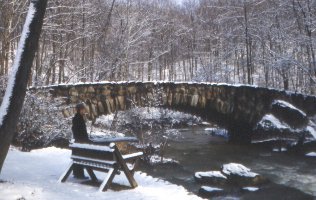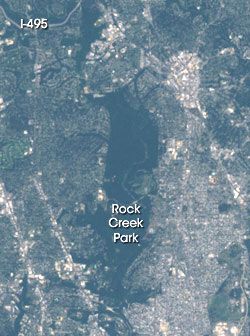| Rock
Creek Park, D. C. |
Will
Blozan |
| Jan
03, 2005 18:02 PST |
ENTS,

I was in MD and Washington DC last week and had one short day to
tree hunt.
The ENTS database lists a tuliptree in Belt Woods (~159') as the
tallest in
the state. I found one on Tuesday that was over 162' in the Rock
Creek
National Park, WDC, just a few hundred yards from the MD border.
From what I
saw while driving, this is just a taste of what the area has to
offer. With
an ENTS representative in DC and MD, a Rucker of 135-140 is
possible. I was
literally blown away by tall trees in the area. I will post a
report soon,
but will send this out as a primer for some DC or MD data that
may not be
out yet. I further suspect that the tallest trees in VA may be
in the DC
area. So many tree sites, so little time!!!!!
Will
|
| Re:
Maryland/WDC tuliptrees |
wad-@comcast.net |
| Jan
04, 2005 04:43 PST |
Will,
ENTS
I used to live in that area also. I can only imagine that there
are many large trees along the Potomac river, especially in the
Great Falls, Va area, where there are alot of save/park areas.
Rock creek has a kudzu problem, or at least they did in the
90's. Did you see any of that while you were there? Out near
Leesburg Va., along the Potomac, there were many giant Sycamore
and persimmon. Happy hunting.
|
| Rock
Creek National Park, Washington, DC |
Will
Blozan |
| Jan
10, 2005 18:02 PST |
ENTS
et al,
Over the holidays I had a day to begin an exploration of Rock
Creek National
Park while I was visiting family in Maryland. Being wholly
unfamiliar with
the park, I chose to drive the extensive network of roads and
thereby scout
areas to explore in more detail later. I will not get into
details of the
park as it has a website dedicated to it that can be found with
an online
search.
I was immediately overwhelmed with good sites for ENTS data
collection, and
had to try very hard to concentrate on the traffic and not the
trees. In the
surrounding communities I saw many HUGE specimens of trees both
native and
exotic that could very well be state or district records. I
finally just
picked a random spot to begin, since it all looked good. I must
admit
however, that I was not at ease in this urban forest when debris
from
muggings and other urban "activities" were everywhere.
It was sad to see
such magnificent woodland marred by human indecency, but the
trees have
prevailed and grown to respectable proportions. Another
depressing sight was
the utter lack of ANY hummus or organic matter except for what
had just
fallen. Essentially the soil was simply exposed dirt with a
layer of dry
leaves a few leaves thick. I suspect European earthworms are to
blame, and
the trees may be suffering from this as well as the gypsy moth.
Since the park is so large (~1600 acres) with another 2000+
acres in
adjacent Rock Creek Regional Park (MD) the possibilities for
more fantastic
trees are a given. The initial Rucker Index for the park is
without a doubt
FAR from a maximum (after all, it is far below Bob's hallowed
Mohawk trail
;). I anticipate a RI of over 140' based on what I have seen.
Stopping was
not only unlawful but often impossible given the national park
status and DC
traffic. I bypassed many nice cottonwoods and sycamores that
alone would
increase the Rucker Index by a few points.
Anyway, here are the numbers I obtained in a few hours.
Miscellaneous trees along the roads and parking areas:
Virginia pine 5'7"
x 98.1' This
species is SUPERB in the DC area. I have no doubt they reach and
exceed 110'. Super gnarl!
Pitch pine 6'11"
x 106' I do not have a good
sense of this species in the area.
American beech 9'2"
x 114'
8'3"
x 118.7' 130' is very
possible.
Black gum 6'9"
x 113.8' 120' is likely,
as the species is quite common and in good form.
Chestnut oak 9'11"
x 122.3' No doubt well below it's height
potential!
Black oak 9'6"
x 129' Dry
site!!! Just a hint of it's potential on a better site.
Tuliptree 10'3"
x 130.9' Very dry site.
10'6" x 135.7' " "
White ash 10'2"
x 126.3' Dry site. 140'+ is a given on the
right site. I bet 150' is possible.
Mockernut 4'4"
x 121.3' Must reach 130'
somewhere in the park.
The Melvin Hazen Nature Trail:
Bald cypress 8'3"
x 91.1' Planted,
super gnarly tree!
N. red oak (var. rubra) 9'8" x 132.7'
" 8'9"
x 135.4' 140'+ is a given on
the right site.
Pignut hickory 6'1"
x 124.9' Just the beginning.
gotta' hit 140' somewhere.
Tuliptree 13'6"
x 157.8'
9'3"
x 162.5' 170' is not out of
the question somewhere up there! This tree is tallest of a twin
stem ~ 16' cbh.
American beech 6'4"
x 111.2'
6'7" x 119.4' Should be
able to reach mid 120's if not 130' on the right site.
Chestnut oak 7'1"
x 121.7'
White oak 8'7"
x 125.9' Many fine specimens
to be found; 130'+ is a given.
Sycamore 5'10"
x 134.3'
6' 136.7' I
know a 150' tree is possible at the latitude- just need more
search time!
Rucker Index of 130.37 (no conifers)
In addition to the above trees I saw and roughed out green ash
to near 120'
and white pine ~ 125'. I kept holding out for better pine and
thus did not
spend the time on the "shorties". I should have
though, in retrospect.
Here is my RI Index prediction for Rock Creek National AND
Regional Park
based on Colby's finds in nearby Belt Woods and field
observations of growth
potential:
Tuliptree 170'
Sycamore 150'+
White ash 150'
Northern red oak 145'+
White oak 140'+
Chestnut oak 140'
Pignut hickory 140'
Black oak 140'+
Cottonwood 135'+
Mockernut 130'+
Rucker Index = 144
Since I do not have enough lifetimes as it is to cover the
Smokies, SOMEONE
needs to take over the DC area and confirm (or refute) my
predictions!
Scott? Ed?
The DC area is a growing machine!
Will |
| Re:
Rock Creek National Park, Washington, DC |
Jess
Riddle |
| Jan
11, 2005 20:06 PST |
I am once again amazed! I believe Rock Creek NP is now only the
fifth
site outside of the Smokies with a tuliptree confirmed over
160'. The
diversity on dry sites sounds excellent, and the black oak is
particularly
impressive. How old are the forests in the park? To what do you
attribute the spectacular growth?
Jess |
| Rock
Creek National Park, Washington, D. C. |
|
http://earthobservatory.nasa.gov/Newsroom/NewImages/images.php3?img_id=16811

Rock Creek National Park is a forested valley running
through the District of Columbia along the banks of Rock
Creek. The national park connects with additional state
park land outside of the district, providing a green
corridor from near the heart of the city out into the
northwestern suburbs. First explored as a location for a
presidential mansion immediately after the Civil War,
the land became a national park in 1890. It was one of
the first of the national parks in the United States,
and it is certainly one of the most easily accessible.
This Landsat 7 natural-color image of Rock Creek Park
shows the deep green vertical stripe of the park in the
image center, with thin extensions north into the
Maryland suburbs and under the I-495 Beltway—the
freeway that encircles Washington and its inner
suburbs—and south through Georgetown to the Potomac
River. Most of the national park portions of Rock Creek
are in this southern area, including the Smithsonian
National Zoo, Peirce Mill, and Old Stone House
Visitor’s Center.
Other striking features in the imagery include major
Washington D.C. landmarks, such as the Capitol, the
National Mall, and the White House and the Ellipse
behind it. The crisp “O” feature east of the Mall in
the bottom right corner of the image is RFK Stadium.
Although the suburbs of the city have hints of green
from suburban landscaping, the character of the
parklands is dramatically different from the surrounding
land, and most especially from the dense grey of
buildings and homes in the city’s center and running
north along the park’s eastern boundary.
These data were collected by Landsat 7’s Enhanced
Thematic Mapper Plus (ETM+) instrument on June 18, 2002.
The image was created by combining data from the red,
green, and blue channels (ETM+ bands 3, 2, and 1
respectively) to show a natural color view.
NASA image created by Jesse Allen, Earth Observatory,
using data obtained from the University of Maryland’s Global
Land Cover Facility.
|
|
| rock
creek |
Darian
Copiz |
| Mar
15, 2005 06:38 PST |
ENTS,
Two weeks ago I measured two trees off of Rock Creek Park in
Washington,
D.C., but didn't get around to posting their dimensions as they
didn't
break any records for the area. The location is the last ravine
feeding
into Rock Creek Park before it reaches the Potomac. The
tuliptree was
in Montrose Park and the white oak was in Dumbarton Oaks Park
which is
separate from Dumbarton Oaks, a nearby mansion and garden that
is
accessible to the public. The two trees I measured were probably
part
of the mansion's property at one time.
tuliptree 19' 2" x 124.0'
white oak 13' 1" x 111.6'
The tuliptree was at the top of the south edge of the west-east
flowing
ravine. It was at the edge of the forested part and had
characteristics
of an open grown tree. The height isn't remarkable, but the
combination
of height and circumference adds up to a pretty respectable
tree. I
found it to be impressive. The white oak was growing lower down
on the
same side of the ravine in the woods in the middle of a slight
swale
which was wetter than other parts of the slope. It also did not
have
any singly significant measurement but was still a good sized
tree.
These may help raise the Rucker Index of Fatness for Rock Creek.
Is the
100, 200, or 300 index of maximum potetial system going to be
used at
some point? I would love to see some tall trees cut down to size
once
circumference is figured in too.
Three weeks ago I had briefly visited the Melvin-Hazen ravine
which Bob
had reported on. I took a few measurements but didn't find the
tallest
tuliptree/tallest top in the ravine.
Darian
|
|